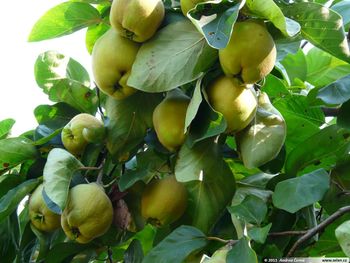Quince
Other Names: Cydonia oblonga Miller, Bedana, Cognassier, Coing, Cydonia oblongata, Cydonia vulgaris, Marmelo, Membrillo, Pyrus cydonia, Quitte, Quittenbaum.
Cydonia oblonga is a fruit tree growing from 8 to 15m, with oval leaves, densely pubescent with fine white hairs; the fruits are large, yellow and pear-shaped, and the flowers are large pink. The flowering lasts from April to May and the harvesting takes place from October to November.
See also : Mu Gua
Special Precautions of Quince
The seeds contain cyanide, which suggests that quince seeds might not be safe. Overdose may cause respiratory failure and death.
Benefits and uses of Quince are
Even when fully ripe, the bright yellow, aromatically fragrant fruits are not usually suitable for eating raw as the flesh is very tart and remains hard and woody. Cooked and sweetened, however, it unfolds a typical, enticing aroma and the fruits are therefore used to make jellies, compotes, juices and cakes. The whole plant has astringent (fruit), anti-inflammatory, emollient and laxative (seeds) properties.
- The quince mucilage relieves irritation. A seed extract is therefore used as a cough remedy and for treatment of gastric and intestinal catarrh.
- It is used for the treatment of Digestive disorders : diarrhea, dysentery, constipation, gastritis and enteritis.
- The herbal infusion is recommended against haemoptysis, diarrhea, vomiting and chronic oral inflammations.
- It is applied externally for the treatment of burns, dry skin and sore eyes.
- Coughs.
- Stomach and intestinal swelling (inflammation).
- Skin injuries, when applied to the skin.
- Mucilaginous compresses made from the crushed seeds can be applied to wounds and inflamed joints : Swollen and painful joints, when applied to the skin.
- The mucilage is also used as a gargle for sore throats.
- Eye discomfort, when applied as a lotion.
- Essential Oil : It has several phenolic compounds such as caffeoylquinic acid, procyanidin-B2, oligomeric procyanidin, polymeric procyanidin etc., and essential oils like furfural, limonene, linalol, vomifoliol, toluene, ß-ionone, a-terpineol, etc. Together; these compounds give quince its unique fragrance.
